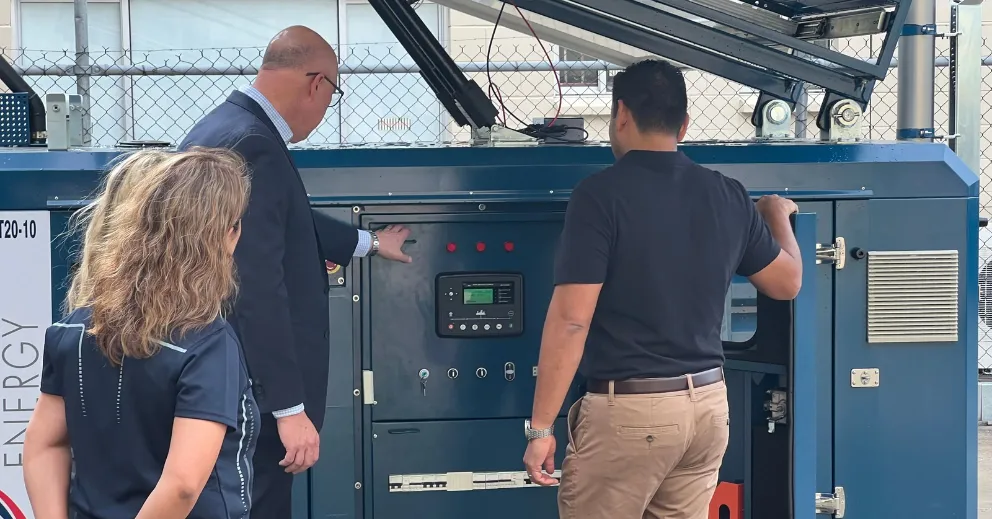When a power outage strikes, having a generator is essential, but having it activate automatically makes all the difference. This is where an Automatic Transfer Switch (ATS) steps in.
It’s the smart device that ensures seamless power transfer between utility power and your backup power source, keeping your home or business running smoothly without manual intervention.
Let’s explore how these systems work with generators, how they differ from a manual transfer switch, and how to choose the right setup for efficient power distribution across your property.
What Is an Automatic Transfer Switch?
An auto transfer switch is an essential electrical device that monitors your utility power and automatically switches to your backup power source if the main supply fails. Once electrical power is restored, it seamlessly transfers you back to the grid without interruption.
Think of it as the brain behind your power distribution system. It detects a power outage, starts your generator, and safely manages the power transfer between different power sources, all within seconds.
Key Benefits of Using an ATS:
- No manual work is required during a power outage, unlike when using a manual transfer switch.
- Enhanced safety by preventing back-feeding into the grid and ensuring proper power distribution.
- Faster power restoration through automatic power transfer between different power sources.
- Ideal for critical electrical load applications such as medical equipment, refrigeration units, and security systems.
- Works seamlessly with load banks for testing and maintaining reliable backup power source performance.
The Working Process of an ATS in Power Transfer
Here’s a step-by-step look at how an auto transfer switch functions with your generator:
- Constant Monitoring: The switch continuously monitors your utility power and detects any loss of electrical power or instability.
- Detecting an Outage: When it senses a power outage or voltage drop, the switch sends a signal to start the backup power source.
- Switching Power Sources: After the generator reaches the correct operating voltage, the switch safely disconnects your property from the grid and connects it to the generator, allowing smooth power transfer between different power sources.
- Power Restoration: Once mains power is restored and stable, the switch automatically transfers back to grid power, managing the electrical load efficiently.
- System Reset: Everything resets and returns to standby mode, ensuring reliable power distribution for the next event.
Where ATS Systems Are Most Commonly Installed?
ATS units are commonly used in places where consistent power is essential:
- Homes: For households that want peace of mind during storms or outages
- Businesses: For retail, offices, and hospitality, where downtime means lost revenue
- Healthcare: Hospitals and aged care facilities rely heavily on ATS setups
- Farms and Remote Properties: Where power reliability is often a challenge
Types of Automatic Transfer Switches
Choosing the right ATS depends on your generator size, load requirements, and whether you need full or partial power coverage.
1. Open Transition ATS (Break-Before-Make)
This common changeover switch momentarily disconnects utility power before switching to the generator. It’s reliable, cost-effective, and suitable for most setups, though it causes a brief power transfer interruption (typically under a second).
2. Closed Transition ATS (Make-Before-Break)
Used in critical systems, this configuration connects the generator before disconnecting mains power, avoiding any loss of electrical power. It’s often used in hospitals, data centres, and other environments with sensitive backup power source needs.
3. Service Entrance Rated ATS
This design combines the main circuit breaker and ATS into one unit, ideal for residential or small commercial sites where simplicity and safe power distribution are key.
Key Considerations Before Installing an ATS
Before getting an auto transfer switch installed, here are a few important factors to keep in mind:
- Generator Compatibility: Make sure your ATS is compatible with the type and size of your generator, including proper connection to your backup power source.
- Load Requirements: Determine whether you want to back up the entire property or only essential circuits, based on your electrical load and overall power distribution needs.
- Professional Installation: Always have your ATS installed by a licensed electrician using the right fuse switch disconnector to ensure safety and compliance with Australian standards.
Do You Need an ATS for Your Generator?
While manual transfer switches do exist (and cost less), they require someone to be on-site and ready to switch power sources manually. That’s not always ideal, especially during a blackout, storm, or when you’re away.
An ATS is the smart choice if:
- You want an uninterrupted power transfer between your backup power source and utility power.
- You’re protecting critical systems that rely on consistent electrical power, such as fridges, medical devices, or computers.
- You want peace of mind knowing your generator will activate automatically during any power outage.
Make Power Worries a Thing of the Past
Whether you're a homeowner looking to avoid the hassle of blackouts or a business owner who can’t afford downtime, an ATS paired with the right generator is a powerful solution.
At Jubilee Energy, we provide expert advice, high-quality generators, and professional ATS installation to make sure your backup power system runs smoothly and safely.
Contact Jubilee Energy today to learn more about how we can help you find the perfect ATS and generator setup tailored to your needs.
More insights from us
Discover the latest in power generation technology.





